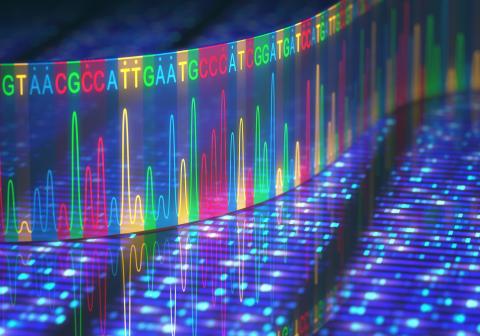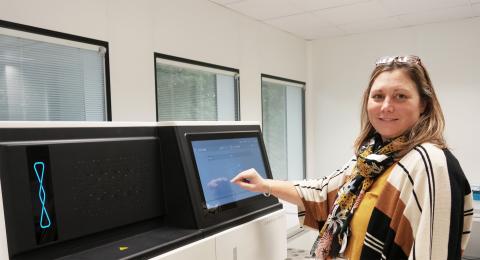
Karine Labadie: The sequencing bug
Karine Labadie is a researcher at the Laboratoire de séquençage (Sequencing laboratory), which is a part of Genoscope (Université Paris-Saclay, CEA). She develops sequencing protocols at the forefront of technological innovation for genomic research on all living organisms and for various projects.
Karine Labadie joined Genoscope eleven years ago as a production manager on the sequencing platform. Since then, this role has gradually evolved into developing increasingly complex sequencing protocols. “At the start, my colleague, Julie Poulain, and I shared the monitoring of all projects, from the extraction to the procurement of sequences, for all the technologies we were working on at the time, with the added responsibility of some specific projects within consortiums.” The researcher had to adapt to the different technologies used by the sequencing instruments as they were introduced, as well as to the wide variety of organisations involved in the projects. “The aim is to extract DNA from complex samples, such as those from the sea as part of the TARA project, and then to sequence them while preserving the diversity present in the initial sample.” To achieve this, she had to implement permanent monitoring. “I do a lot of reading and I'm always on the lookout for new things that could help us in our projects.”
Adaptability and flexibility
These are the key words which govern Karine Labadie’s everyday work. “Development involves ‘tinkering,’ but with precision! I have to operate across a very broad range of stages - from nucleic acid extraction to sequencing - in order to improve the sequencing for projects.” Together with colleagues, the researcher has also implemented the High Chromosome Contact map (Hi-C). This technology provides access to three-dimensional genome architecture in order to improve assembly after sequencing using the Illumina or Oxford Nanopore technologies. She is still at the evaluation stage for given single-cell organisms. “We obtain a snapshot which fixes the DNA so that we can identify the areas which interact together and the biological impact this can have according to certain phenotypes.”
Sequencing giant viruses which have been brought back to life
Karine Labadie’s team is constantly adapting its approaches and methods to a multitude of isolated and mixed organisms (known as metagenomics). These include animals, plants, fungi, bacteria and even viruses - all of which have their own particularities, including some that are unknown. One of her projects has recently created quite a stir. Jean-Michel Claverie’s team (Université d’Aix-Marseille), known for tracking giant viruses, went to sample the permafrost in Siberia. “Researchers extracted frozen soil cores and recovered giant viruses the size of bacteria in different proportions corresponding to different dates (in thousands of years). Then they revived them by cultivating them on amoebas, which are very primitive, single-cell organisms. We have sequenced two of these giant viruses, which date back 30,000 years. This is as equally exciting as it is worrying because with global warming, permafrost could release viruses into the environment against which we no longer have any protection today.”
Fascinated by viruses
“As early as the sixth grade, I knew that I wanted to be a researcher in biology.” Karine Labadie carried out her scientific training in the south of France, which is where she is originally from. She then left for Paris to study a Master’s at Université Pierre et Marie Curie. In 2004, she defended a thesis at the Pasteur Institute on the poliomyelitis virus and followed this up with two post-docs. The first was done at the Pasteur Institute with Nadia Naffakh’s and Sylvie Van Der Werf’s team, which focused on the avian flu virus. For the second, she studied the chikungunuya virus at IDMIT (Infectious Diseases Models for Innovative Therapies – CEA) under the supervision of Pierre Roques and Roger Le Grand. After she had completed her second post-doc in 2009, she was recruited by Genoscope. “Even though the job profile was more engineering than research, the fact that I would be working on such a wide range of living organisms (with the exception of humans) and using a broad scope of cutting-edge biotechnologies made the job very attractive.”
The role of a researcher for Karine Labadie is one of fascination, freedom and the sharing of information and knowledge. “Projects can also move forwards thanks to discussions over coffee. I don’t believe in researchers working alone!” Joining Genoscope remains a high point in her career. “I was a little worried about leading a team for the first time, but I have met some extraordinary people. They are my daily dose of sunshine.”
The researcher recently attended the tribute paid by Université Paris-Saclay to its most celebrated researchers, of which she has been a member for the past two years. “It’s lovely, of course. However, all those people who work alongside us should also be recognised. Results are only achieved through teamwork.”

